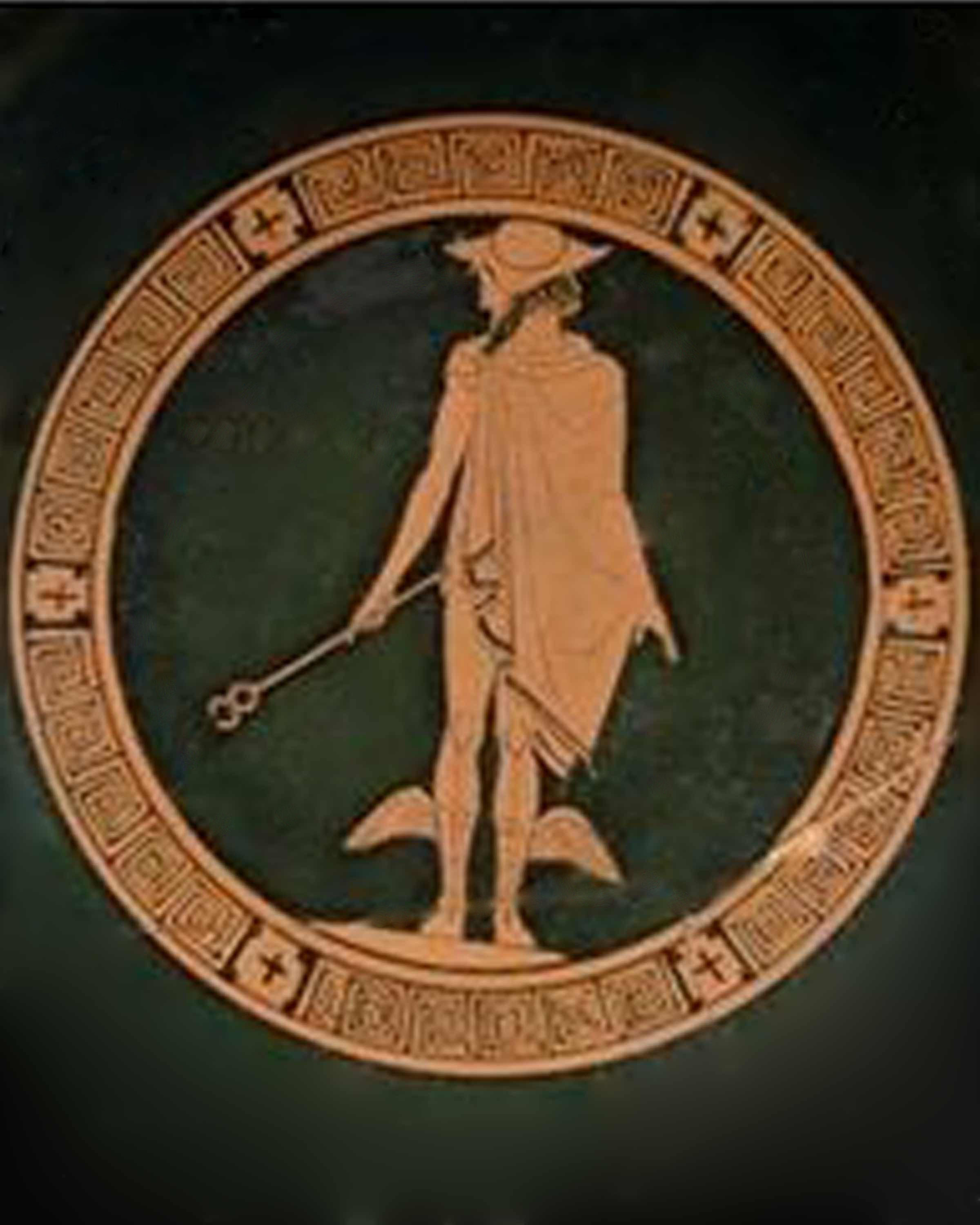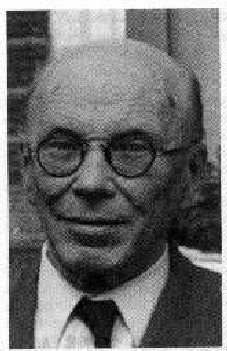Valentin Tomberg Bibliography
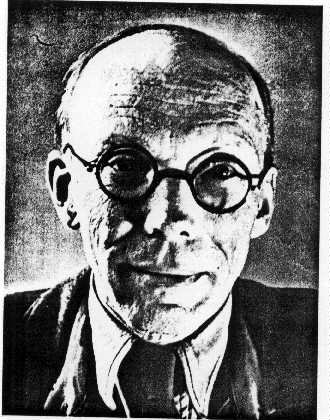
Bibliography for Teleconference Study Group for Meditations on the Tarot
Visit our Tarot Bookstore for Immediate Access to Books Related to our Study
Survey of Some Editions of Meditations
Meditations on the Tarot by Anonymous, afterword by Hans Urs von Balthasar, translated by Robert Powell (Tarcher) Published for the first time with an index and Cardinal Hans Urs von Balthasar's afterword, this new English publication of Meditations on the Tarot is the landmark edition of one of the most important works of esoteric Christianity. Written anonymously and published posthumously, as was the author's wish, the intention of this work is for the reader to find a relationship with the author in the spiritual dimensions of existence. The author wanted not to be thought of as a personality who lived from 1900 to 1973, but as a friend who is communicating with us from beyond the boundaries of ordinary life
Anonymous (like all the other editions and translations), Meditationen fiber die Grossen Arcana des Tarot: 22 Briefe an den unbekannten Freund (Gertrud von Hippel, edited.and translated, preface by Ernst von Hippel), Maisenhain am Glau: Anton Hain, 1972
New French Edition: Der Anonymus d'Outre Tombe: Die Grossen Arcana des Tarot. Meditationen (new trans. by Franz Oesig etc. of the French manuscript, with many notes from Martin Kriele etc., and a trans. of the 1984 preface [cf. below] by Hans Urs von Balthasar), 2. vol., Basel: Herder, 1983,(this is the edition pictured with Pope John Paul II), reprint 1993 .
French: Meditations sur les 22 arcanes majeurs du Tarot, par un auteur qui a voulu conserver l'anonymat (first edition of the original French manuscript, with a foreword by Hans Urs von Balthasar), Paris: Aubier-Montaigne, 1980; Revised edition 1984 (with a slightly different version of the foreword by H.U. von Balthasar, and a preface by Robert Spaemann)
German: Die Grossen Arcana des Tarot - Meditationen: Die Großen Arcana des Tarot, Ausg.A, 4 Bde., Bd.1: Bd 1 (Sammlung Überlieferung und Weisheit) von Martin Kriele, und Robert Spaemann von Herder, Freiburg (Taschenbuch - Januar 1993)
Die Grossen Arcana des Tarot - Meditationen: Die Großen Arcana des Tarot, Ausg. A, 4 Bde., Bd.2: Bd 2 (Sammlung Überlieferung und Weisheit) von Martin Kriele, und Robert Spaemann von Herder, Freiburg (Taschenbuch - Januar 1992)
Die Grossen Arcana des Tarot - Meditationen: Die Großen Arcana des Tarot, Ausg. A, 4 Bde., Bd.3: Bd 3 (Sammlung Überlieferung und Weisheit) von Martin Kriele, und Robert Spaemann von Herder, Freiburg (Taschenbuch - Dez. 1998)
Die Grossen Arcana des Tarot - Meditationen: Die Großen Arcana des Tarot, Ausg. A, 4 Bde., Bd.4: Bd 4 (Sammlung Überlieferung und Weisheit) von Martin Kriele, und Robert Spaemann von Herder, Freiburg (Taschenbuch - Dez. 1992)English: Meditations on the Tarot: A Journey into Christian Hermeticism (trans. by Robert A. Powell), New ed. (same translation; with H.U. von Balthasar's text as Afterword), New York: Jeremy P. Tarcher/Putman, (NY) 2002
Other editions in Italian, Spanish, Portuguese, Russian.
Description of Meditations
This evaluation is derived from Antoine Faivre’s essay in
Dictionary of Gnosis & Western Esotericism edited by
Wouter J. Hanegraaff (Brill Academic) and his essay "Analysis of the
Meditations of Valentin Tomberg on the Twenty-Two Major Arcana of
the Tarot of Marseilles", in
Theosophy, Imagination, Tradition: Studies in Western Esotericism
(SUNY
series in Western Esoteric Traditions
It is obvious that in terms of presentation, Tomberg's Meditations was influenced by a work of the Russian Vladimir Chmakov (a name which Tomberg quotes only occasionally) The Great Arcana of the Tarot, the Absolute Beginning of the Synthetical Philosophy of Esotericism (in Russian, Moscow 1916; repr. Moscow 1993).
Both Chmakov's book and Tomberg's Meditations are subdivided into twenty-two chapters whose contents only tenuously correspond to their titles. Each title consists of the name of one of the Major trumps, but seems merely a formal pretext for introducing reflections not actually related to the symbolism of the card (not unlike Montaigne's Essais or Foix-Candale's Le Pimandre d'Hermes Trismégiste in the 16th century, in which the titles of the chapters are likewise only loosely related to the discussions they announce).
Taken as a whole, Tomberg's Meditations is nonetheless characterized by a very coherent unity of thought and inspiration. Not at all a new method for reading the Tarot, it is, rather, a synthesis of the life-long meditations of a Christian hermeticist.
The author of Meditations is well versed in both Christian theology and the literature of modern Western esoteric currents (15th to 20th centuries), primarily spiritual alchemy, classical theosophy [ Christian Theosophy], Naturphilosophie, as well as the more recent so-called Occultist current. The book is a blend, as it were, of those currents and of Roman Catholicism as Tomberg understood it. He finds himself in contradiction with regard to Catholicism, however, in so far as he declares himself a defender of the belief in reincarnation. With regard to what he calls "hermeticism" that is esotericism as the form of thought of modern Western esoteric currents), he discusses a great many of its representative figures, and defines the hermeticist as the theologian of a Holy Scripture which is that of "the World".
In other words, for Tomberg there are two complementary theologies: the first or classical one is that of the established Churches, the second one is an hermeticism, which is ultimately a Philosophy of Nature. Like the romantic Naturphilosophen (to whom, nevertheless, he barely refers), throughout his book he evinces a strong tendency to think in terms of polarities at all the levels of reality (material, psychic, spiritual, divine, etc.), in the existence of which he believes.
Although also very much at home in the literature of the Occultist current -especially the francophone one of Stanislas de Guaita, (April 6, 1861- December 19, 1897) is a French occultist and poet, cofounder with Joséphin Péladan (a writer and French occultist March 28, 1858 Lyon-The Neuilly-on-Seine June 27, 1918. pseudonym: Sâr) of the Cabbalistic Order of the Rosicrucian Brotherhood, Papus (Gérard-Anaclet-Vincent Encausse), Eliphas Levi , etc. Tomberg is quite critical of many forms of practical magic, and in this connection may be said to stand in the wake of the form of theosophy represented by, for instance, Louis-Claude de Saint-Martin, whom he appreciates and with whom he shares many commonalities.
Indeed, Tomberg can be considered a theosopher in the classical sense of the term, although he only uses the word in the context of discussions of the ideas of the Theosophical Society. In addition, he lavishly reflects on figures representative of classical Christian mysticism. In an original and creative way, he compares Christian mysticism to both Eastern orthodox mysticism and Western hermeticism.
Furthermore, Tomberg discusses some major issues of psychoanalysis, aligning with Carl Gustav Jung, whose views he tries to complement by adding to analytical psychology the dimension of what he calls "transconsciousness".
In sum, Meditations may be defined as both a compendium of modern Western esotericism and a stimulating critique of some of its aspects, containing many profound thoughts and beautiful poetic passages. In terms of contents and reception it has to be positioned among the foremost books in Western esotericism published in the 20th century.
Written in French but first published in a German translation (1972), Meditation went through several translations and editions.
The felicitous initiative of publishing the manuscript is mainly to the credit of Martin Kriele, a German jurist (and successor of Ernst von Hippel, (see) who considered himself Tomberg's spiritual heir. In the 1970s and 1980s, under the pretext of respecting Tomberg's anonymity, the editors and publishers of the book have contributed to the creation of an aura of conspiratorial mystery around its author. This insistence on secrecy has been partly responsible for the Meditations initial success, but eventually, and not unexpectedly, lost force.
Be that as it may, the interest in Tomberg triggered by his Meditations is mainly responsible for the subsequent publication and/or re-issues of some of his other writings. As a matter of fact, the reception of Tomberg's works already has a complex and rich history (especially since the beginning of the 1970s). This reception has taken on three main aspects.
First, a great many enthusiastic readers have authored laudatory articles on Tomberg, mainly on the Meditations.
Second, Tomberg is the subject of severe criticism in a plethora of writings emanating from the Anthroposophical Society. For example, Prokofieff warns anthroposophists to steer clear of him. He considers Tomberg as a secret disciple of the Jesuits, a Catholic agent inimical to the "true" message of Rudolf Steiner (the fact that Cardinal Hans Urs von Balthasar was chosen by the editors of Meditations for writing the preface served to fuel such a critique) and as a hermeticist infected with the occultist stream represented by Eliphas Levi, Stanislas de Guaita, Papus, etc.
And third, since the beginning of the 1990s there has been an increasing amount of objective scholarly studies devoted to Tomberg. Most important among them are the publications of the Ramsteiner Kreis (The Ramsteiner Circle, founders: Liesel Heckmann, Otto Kröner, Max Victor Limbacher, Wilhelm Maas, Esther Näck, Christian Schwartz and Gisela Storto-Lanfer), a Society established in 1990 to study Tomberg's life and works.
Meditations on the Tarot: A Journey into Christian Hermeticism Website
Pope John Paul II and Meditations on the Tarot
Pope John Paul II was presented with a copy of the two-volume German third edition of Meditations on the Tarot by Cardinal Hans Urs von Balthasar, who wrote a foreword to it. Below, you can see a photo of the Pope with these volumes at the bottom of the pile of books on his desk. Underneath are a close-up of the two volumes, and a clearer image of another copy for comparison. Thanks to Ed Mahood for making these images available.
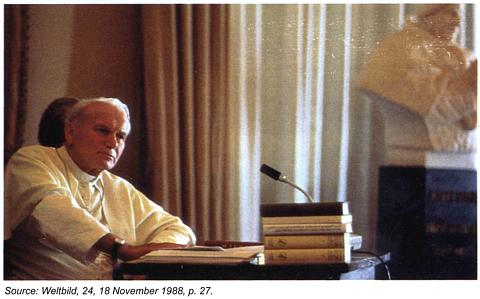
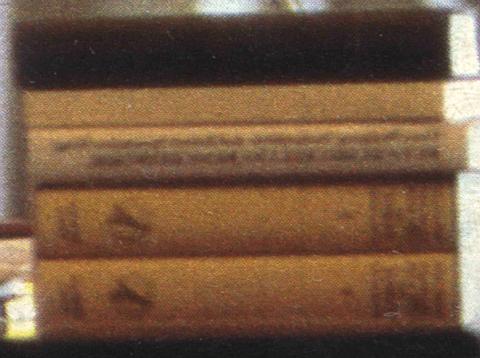
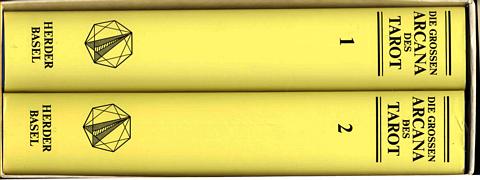
The Best Collection Tomberg's Writings in German
Valentin Tomberg - Leben Bd.I.1 von Liesel Heckmann (Novalis Verlag)
Valentin Tomberg. Leben - Werk - Wirkung: Valentin Tomberg, Band I.2. 1944 - 1973. von Elisabeth Heckmann (Novalis Verlag)
Valentin Tomberg -Leben, Werk, Wirkung, Bd.3 : Wirkung: Bd III von Elisabeth Heckmann (Novalis Verlag)
Some Other Editions of Tomberg's Writings
Lazarus, komm heraus (title given by Martin Kriele, ed.), Basel/Freiburg: Herder, 2985;
Lazarus, Come Forth! by Valentin Tomberg
English: Covenant of the Heart: Meditations of a Christian Hermeticist on the Mysteries of Tradition (translation and edited by Robert Powell and James Morgante), Rockport (MA): Element Books, 1992
Covenant of the Heart: Meditations of a Christian Hermeticist on the Mysteries of Tradition by Valentin Tomberg, and translated Robert Powell (Element Books)
Anthroposophische Betrachtungen fiber das Alte Testament (Willi Seiss, editor), Schonach/Bodensee: Achamoth, 1989 (edited in part in 1933)
Anthroposophische Betrachtungen fiber das Alte Testament und die Apokalypse (Martin Kriele, editor), Schonach/Bodensee: Achamoth, 1989 (ed. in part in 1933);
English: Anthroposophical Studies of the New Testament, Hudson (NY): Anthroposophic Press, 1985
Sieben Vortriige fiber die innere Entwickelung des Menschen, Schonach/Bodensee: Achamoth, 1993;
The Covenant of the Heart: Meditations of a Christian Hermeticist on the Mysteries of Tradition by Valentin Tomberg
Inner Development: Seven Lectures : Rotterdam 15-22 August 1938 by Valentin Tomberg
Anthroposophical Studies of the New Testament by Valentin Tomberg (translation by R. and P. Bloeden)(Anthroposophic Press)
Anthroposophical Studies of the Old Testament by Valentin Tomberg
Essay Articles: Spiritual Science and the World Situation by Valentin Tomberg
Christ And Sophia: Anthroposophic Meditations on the Old Testament, New Testament, And Apocalypse by Valentin Tomberg and Christopher Bamford
Four Sacrifices of Christ and the Appearance of Christ by Valentin Tomberg
Dictionnaire critique de l'ésotérisme par Jean Servier, Michel Saint-Paul, "Tomberg, Valentin", (Paris: Presses Universitaires de France, 1998, 1301-1303)
Gerhard Wehr, "Valentin Tomberg und die grossen Arcana des Tarot", in: G. Wehr, Spirituelle Meister des Westens: Leben und Lehre, (Munich: Hugendubel, Heinrich, Verlag).
Der Fall Tomberg. Anthroposophie oder Jesuitismus von Sergej O. Prokofieff und Christian Lazarides (Verlag am Goetheanum)
The Case of Valentin Tomberg: Anthroposophy or Jesuitism? by Sergei O. Prokofieff, translated by Richard Mitchell (Temple Lodge Publishing)
von Martin Kriele von Herder, Freiburg (Gebundene Ausgabe - Februar 1996)Recent Titles by and about Valentin Tomberg
Meditations on the
Tarot: A journey into Christian Hermeticism
by Anonymous, translated from the French by Robert Powell, Afterword by Hans Urs von
Balthasar (Tarcher, Putnam) Now in a fully corrected edition,
one of the true spiritual classics of the twentieth century.
Published for the first time with an index and Cardinal Hans Urs von
Balthasar's afterword, this new English publication of Meditations
on the Tarot is the landmark edition of one of the most important
works of esoteric Christianity. Written anonymously and published
posthumously, as was the author's wish, the intention of this work
is for the reader to find a relationship with the author in the
spiritual dimensions of existence. The author wanted not to be
thought of as a personality who lived from 1900 to 1973, but as a
friend who is communicating with us from beyond the boundaries of
ordinary life.
Russian Spirituality and Other Essays: Mysteries of Our Time Seen
Through the Eyes of a Russian Esotericist by Valentin Tomberg,
James Wetmore, and Robert Powell
Studies on the Foundation Stone Meditation by Valentin Tomberg,
Robert Powell, and George Adams
The Wandering Fool: Love and its Symbols, Early Studies on the Tarot
by Anonymous, Robert Powell, and Valentin Tomberg
Robert A. Powell Selected Titles
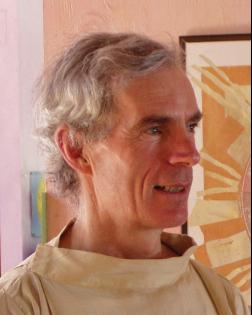
Other References
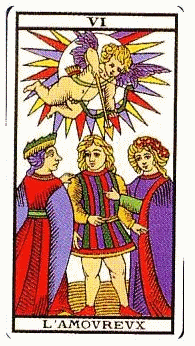 Camoin-Jodorowsky
Tarot de Marseille
Camoin-Jodorowsky
Tarot de Marseille
The illustrations used for the Tarot de Marseille in Tarcher reprint of the Meditations most closely approximate the Camoin-Jodorowsky, Tarot de Marseille (1997). French Tarot scholars, Camoin and Jodorowski have restored crisp detail and outlines in their variation of the Tarot of Marseilles woodcut images. This is a restored, redrawn version with “a few symbols added.”
see Major Arcana Tarot de Marseilles Camoin- Jodorowsky
Read a review by Jean-Michel David of the Tarot de Marseille (Camoin-Jodorowsky)
at Aeclectic.net, a central resource for critical opinion in the
Tarot community.
One can order the Camoin-Jodorowsky Tarot de Marseille deck through the these Internet Sites:
Colors and Redrawing in the Camoin-Jodorowsky Tarot
of Marseille
The following is a reprint of information at the Camoin Website.
In 1998, the Tarot of Marseille rediscovered a symbolic structure which had been lost over time thanks to Philippe Camoin and Alexandre Jodorowsky. The Tarot of Marseille, Camoin and Jodorowsky, contains all the symbolisms already known and more than a dozen new symbols of which professors, experts and amateurs will not be able to do without any more. Only the colors are radically different from certain Tarot of Marseille cards which only contain red, yellow and blue - without light blue or any other colors involved. Originally, these primary colors simply red, yellow and blue, non-initiatory, were copied from a Camoin pack dated in 1880 at the time of the industrial era and the appearance of machines. These machines are only able to print the four primary colors. In the years 1860-1880, Philippe Camoin’s ancestor, who was the last and unique CardMaster in Marseille felt, indeed, constraint to invent these new colors that could adapt to the machines. Thus was born a particular edition created for mass production. It is these invented primary colors and non-initiatory from 1880 which were used, 50 years later, by other printers.
Since 1930, for over 70 years, the public wrongly thought that these colors had an esoteric significance. Since 1998, the new colors of the Tarot of Marseille, Camoin and Jodorowsky, are the reflection of the authentic alchemical tradition.
This reconstitution of the Tarot of Marseille is a major event in the history of the Tarot. Many generations of researchers have studied the last existing Tarots in the search of initiatory secrets. It seems that Philippe Camoin and Alexandre Jodorowsky have been the ones who have discovered them.
Philippe Camoin and Alexandre Jodorowsky are two Masters of the Tarot and both teach on this subject. Alexandre Jodorowsky has given lessons on the Tarot of Marseille for many years now. He is a legendary film director and has directed several initiatory full-length films, scriptwriter for comic strips and is passionate about the Tarot and has been for over 40 years. As for Philippe Camoin, he teaches his own method respecting the new major discoveries concerning the structure of the Tarot.
A few months ago (in 1997), Philippe Camoin, revealed to Tarot experts of the world, the date of the oldest existing pack of Tarot of Marseille manufactured in Marseilles. It belongs to François Chosson going back to 1672 and of which no one knows the origin. An American expert, Doctor Robert O' Neil, in contact with Philippe Camoin was able to find information going back to as far as 1608. We are far from the date of 1760 of which the historians speak of up until now.
Philippe Camoin has also just revealed new historical data which could well change the order of appearance of the Tarot in the West. According to him, it was the monk Jean Cassien, founder of the abbey of Saint-Victor in Marseilles, in year 400 after J.-C. who arrived from Egypt and who contributed to transmitting to Western Europe the secret doctrines strongly influenced by Origen. It certainly was the Saint-Victor Order, who in the years 1000, reigned all over the territory where, later, the oldest Tarots were found and the oldest reference to the Tarot. This territory was the North of Italy, the North of Spain and the south of France, territory on which bloomed the cathars and templars.
Philippe Camoin is the last heir to Marseille’s Master Card Makers. The CAMOIN House goes back to Nicolas CONVER who engraved in 1760 his Tarot of Marseille by perpetuating the tradition of Masters going way back to the elders of which François Chosson (1672) is an example. In the 19th century, the Camoin House collected the tradition of all Marseille’s Master Card Makers and became unique in Marseille.
The re-composition of the Tarot of Marseille by Camoin and Jodorowsky will initiate the revival of a Tradition, existing beyond a simple card deck and of which has been dormant for several centuries.
This re-composition is a complex process of comparison between the symbols present on many decks in Europe and the whole process according to the authentic tradition of the Tarot of Marseille. This work calls for an extremely precise initiatory logic. It is not just a question of copy or restoration as we know of, from an older deck of cards. The term "Restoration of the Original Tarot" implies a restoration of a complex philosophical system. The Tarot is indeed regarded as an initiatory knowledge, a metaphysical machine where the cards are only a support. Together, Philippe Camoin and Alexandre Jodorowsky re-composed the symbolism of the Tarot of Marseille as it should have been originally, the original deck having disappeared from the general public. They have also added their specific elements of which they hold the secrecy like Master Card Makers have always done in the past.
The original symbols have been lost with time over generations of Master Card Makers. The discovery of the egg situated at the bottom of the eagle in the "Emperor" card was a decisive moment and confirmed that a quantity of forgotten symbols was hidden: waiting to be revealed. The other discoveries can help understand the logic with which the Tarot was originally built. Among the other restored symbols easily understood by the general public, we can add: the two snakes intertwined at the foot of "Temperance" and the four elements in the Ace of Cups.
Of all these new symbols re-composed in the Tarot of Marseille springs new teachings adapted to the XXI st century and initiated by Philippe Camoin and Alexandre Jodorowsky.
see related pages
Robert A. Powell
Anthroposophy
Rudolf Steiner
Etheric Christ
Meditations on the Tarot by Anonymous Teleconference Info
Online edition of Meditations on the Tarot by Anonymous
Pdf file of Online edition of Meditations on the Tarot by Anonymous
Index to Meditations on the Tarot
Links to Webpages about Meditations on the Tarot
Major Arcana Tarot de Marseilles Camoin- Jodorowsky
